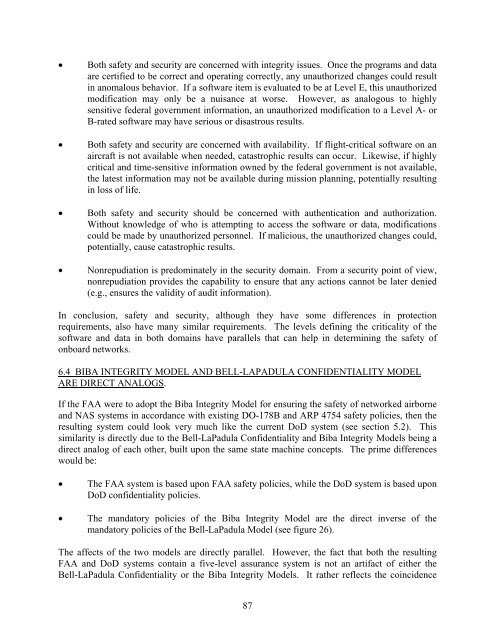Local Area Networks (LANs) in Aircraft - FTP Directory Listing - FAA
Local Area Networks (LANs) in Aircraft - FTP Directory Listing - FAA
Local Area Networks (LANs) in Aircraft - FTP Directory Listing - FAA
Create successful ePaper yourself
Turn your PDF publications into a flip-book with our unique Google optimized e-Paper software.
• Both safety and security are concerned with <strong>in</strong>tegrity issues. Once the programs and data<br />
are certified to be correct and operat<strong>in</strong>g correctly, any unauthorized changes could result<br />
<strong>in</strong> anomalous behavior. If a software item is evaluated to be at Level E, this unauthorized<br />
modification may only be a nuisance at worse. However, as analogous to highly<br />
sensitive federal government <strong>in</strong>formation, an unauthorized modification to a Level A- or<br />
B-rated software may have serious or disastrous results.<br />
• Both safety and security are concerned with availability. If flight-critical software on an<br />
aircraft is not available when needed, catastrophic results can occur. Likewise, if highly<br />
critical and time-sensitive <strong>in</strong>formation owned by the federal government is not available,<br />
the latest <strong>in</strong>formation may not be available dur<strong>in</strong>g mission plann<strong>in</strong>g, potentially result<strong>in</strong>g<br />
<strong>in</strong> loss of life.<br />
• Both safety and security should be concerned with authentication and authorization.<br />
Without knowledge of who is attempt<strong>in</strong>g to access the software or data, modifications<br />
could be made by unauthorized personnel. If malicious, the unauthorized changes could,<br />
potentially, cause catastrophic results.<br />
• Nonrepudiation is predom<strong>in</strong>ately <strong>in</strong> the security doma<strong>in</strong>. From a security po<strong>in</strong>t of view,<br />
nonrepudiation provides the capability to ensure that any actions cannot be later denied<br />
(e.g., ensures the validity of audit <strong>in</strong>formation).<br />
In conclusion, safety and security, although they have some differences <strong>in</strong> protection<br />
requirements, also have many similar requirements. The levels def<strong>in</strong><strong>in</strong>g the criticality of the<br />
software and data <strong>in</strong> both doma<strong>in</strong>s have parallels that can help <strong>in</strong> determ<strong>in</strong><strong>in</strong>g the safety of<br />
onboard networks.<br />
6.4 BIBA INTEGRITY MODEL AND BELL-LAPADULA CONFIDENTIALITY MODEL<br />
ARE DIRECT ANALOGS.<br />
If the <strong>FAA</strong> were to adopt the Biba Integrity Model for ensur<strong>in</strong>g the safety of networked airborne<br />
and NAS systems <strong>in</strong> accordance with exist<strong>in</strong>g DO-178B and ARP 4754 safety policies, then the<br />
result<strong>in</strong>g system could look very much like the current DoD system (see section 5.2). This<br />
similarity is directly due to the Bell-LaPadula Confidentiality and Biba Integrity Models be<strong>in</strong>g a<br />
direct analog of each other, built upon the same state mach<strong>in</strong>e concepts. The prime differences<br />
would be:<br />
• The <strong>FAA</strong> system is based upon <strong>FAA</strong> safety policies, while the DoD system is based upon<br />
DoD confidentiality policies.<br />
• The mandatory policies of the Biba Integrity Model are the direct <strong>in</strong>verse of the<br />
mandatory policies of the Bell-LaPadula Model (see figure 26).<br />
The affects of the two models are directly parallel. However, the fact that both the result<strong>in</strong>g<br />
<strong>FAA</strong> and DoD systems conta<strong>in</strong> a five-level assurance system is not an artifact of either the<br />
Bell-LaPadula Confidentiality or the Biba Integrity Models. It rather reflects the co<strong>in</strong>cidence<br />
87
















